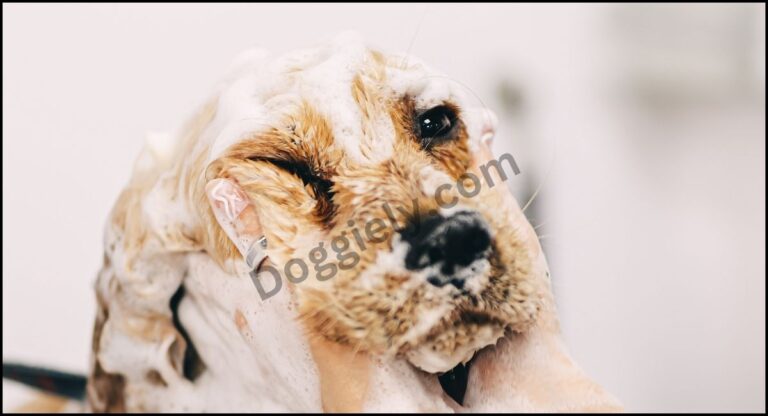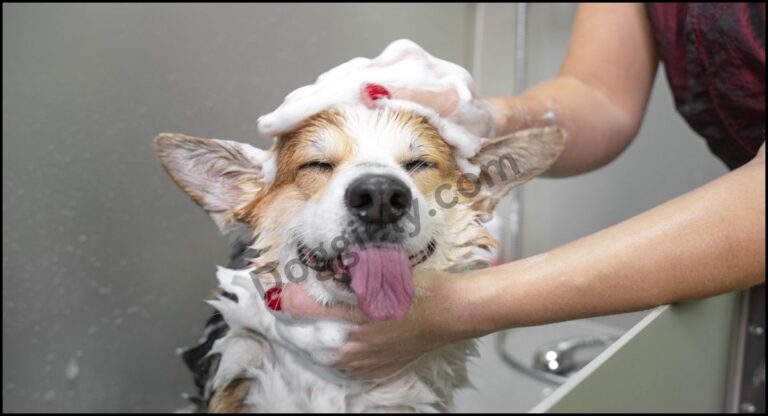corgi pomeranian mix: essential grooming tips

The Corgi Pomeranian mix, often referred to as a “Corgipom,” is a hybrid dog breed that combines the characteristics of the Welsh Corgi and the Pomeranian. This breed overview will introduce you to this unique and delightful mixed breed.

History and Origin
As said earlier, Corgi Pomeranian mix, often affectionately known as the “Corgipom” or “Pom-Corgi,” is a relatively recent addition to the world of designer dog breeds. This mixed breed combines two well-established breeds, each with its own rich history, to create a unique and increasingly popular companion dog. Understanding the history and origin of the Corgi Pomeranian mix requires looking at the backgrounds of both parent breeds.
The Welsh Corgi: The Welsh Corgi is an ancient breed with two distinct varieties: the Pembroke Welsh Corgi and the Cardigan Welsh Corgi. Originating in Wales, Corgis have a history steeped in herding. They were used by farmers to herd cattle, sheep, and horses, utilizing their low stature to nip at the heels of larger animals while avoiding kicks. The Pembroke Welsh Corgi, in particular, gained immense popularity due to its association with Queen Elizabeth II of the United Kingdom, who has owned and bred Pembroke Corgis for decades.
The Pomeranian: The Pomeranian, named after the Pomerania region in Central Europe (now part of Poland and Germany), is a breed of the Spitz type. Known for its small size and luxurious coat, the Pomeranian has been a popular companion animal for centuries. Historical figures such as Queen Victoria of England were enthusiasts of the breed, which contributed to its popularity. Over time, breeders selectively bred Pomeranians to be smaller, resulting in the toy-sized dogs we see today.
The Corgi Pomeranian Mix: The Corgi Pomeranian mix is a more recent development, likely emerging with the rising popularity of designer dog breeds in the late 20th and early 21st centuries. As with many mixed breeds, the exact origin of the Corgipom is not well-documented. The goal of breeding these two dogs together was likely to combine the Corgi’s herding instincts and friendly nature with the Pomeranian’s small size and fluffy coat.
Popularity and Recognition: While the Corgi Pomeranian mix is recognized by various hybrid and designer dog registries, it is not recognized by major kennel clubs that only register purebred dogs. The popularity of Corgipoms has been growing, especially among those who appreciate the unique blend of the physical and personality traits of Corgis and Pomeranians.

Unique Physical Characteristics
Here’s a table that analyzes the unique physical characteristics of Corgi Pomeranian mixes:
| Characteristic | Description |
|---|---|
| Size | Small stature, typically weighing between 10 to 20 pounds |
| Coat Type | Thick double coat, often fluffy, can vary in length |
| Coat Color | Varies widely, including colors like tan, white, black, red, and combinations |
| Body Shape | Can have elongated body like a Corgi or a more compact frame like a Pomeranian |
| Ear Type | Ears can be erect like a Pomeranian’s or slightly drooping like a Corgi’s |
| Tail Type | Varies; some inherit the Corgi’s short tail, while others have a Pomeranian’s fluffy tail |
| Eye Shape | Can have almond-shaped eyes like a Pomeranian or more rounded eyes like a Corgi |
| Nose | Black or brown, depending on the coat color and genetics |
| Leg Length | Shorter legs like a Corgi or slightly longer, more proportionate to the body like a Pomeranian |
| Temperament | Energetic, affectionate, and intelligent; can be strong-willed |
| Lifespan | Typically lives for 12 to 15 years with proper care |
Common health Concerns
Here’s a table that outlines common health concerns in Corgi Pomeranian mixes and how to manage each of them:
| Health Concern | Description | Management Strategies |
|---|---|---|
| Dental Issues | Prone to dental problems like plaque accumulation, tooth decay, gum disease. | Regular dental check-ups, good oral hygiene, and dental cleanings as needed. |
| Orthopedic Problems | Risk of intervertebral disc disease (IVDD) and hip dysplasia due to long back and short legs. | Maintain a healthy weight, avoid excessive jumping and strenuous activities. |
| Obesity | Tendency towards obesity, which can exacerbate joint problems and lead to other health issues. | Balanced diet and regular exercise to prevent excessive weight gain. |
| Skin Allergies | Potential for skin allergies causing itching, redness, and hair loss. | Consult a veterinarian for appropriate treatments, use hypoallergenic grooming products. |
| Eye Problems | Susceptibility to cataracts, progressive retinal atrophy, and other eye issues. | Regular eye examinations, early detection and treatment of any issues. |
| Heart Conditions | Predisposition to heart issues like patent ductus arteriosus (PDA) and collapsing trachea. | Routine veterinary check-ups to monitor heart health, early detection of problems. |
| Luxating Patella | Common in small breeds, where the kneecap dislocates or moves out of place. | Regular vet visits for monitoring, surgery in severe cases. |
| Coat Care and Skin Issues | Requires regular grooming; may have skin sensitivities requiring special care. | Regular grooming, attention to grooming products, and regular skin checks. |
This table provides a comprehensive overview of the potential health challenges a Corgi Pomeranian mix might face, along with practical strategies to manage them.
Here’s a table analyzing different types of allergies, their symptoms, and management strategies in Corgi Pomeranian mixes:
| Type of Allergy | Symptoms | Management Strategies |
|---|---|---|
| Environmental Allergies | Skin irritations, redness, itching, respiratory issues like sneezing or coughing. | Regular bathing with hypoallergenic shampoos, keeping home free of dust and allergens, antihistamines or corticosteroids as prescribed. |
| Food Allergies | Gastrointestinal issues like vomiting or diarrhea, skin irritations, ear infections. | Elimination diet to identify offending ingredients, hypoallergenic or limited-ingredient diet, monitoring reaction to new foods. |
| Flea Allergy Dermatitis | Intense itching, skin redness, hair loss, especially around the base of the tail. | Regular use of flea prevention products, treating the environment, corticosteroids or antihistamines for symptom relief. |
Nutritional Needs
The nutritional needs of a Corgi Pomeranian mix are crucial for its overall health and well-being. As a small to medium-sized breed with a relatively high energy level, this mix requires a balanced diet that supports its unique physical and metabolic requirements. A diet that is balanced and complete is essential. Look for dog foods that meet the nutritional standards established by the Association of American Feed Control Officials (AAFCO). These foods should contain a good balance of proteins, carbohydrates, fats, vitamins, and minerals. Proper nutrition plays a significant role in maintaining their health, energy levels, and quality of life.
Exercise Requirements
Here’s a table analyzing the exercise requirements for a healthy Corgi Pomeranian mix and their beneficial effects on health:
| Exercise Type | Description | Health Benefits |
|---|---|---|
| Daily Walks | Moderate-paced walks, essential for physical health and mental stimulation. | Improves cardiovascular health, aids in weight management, reduces anxiety. |
| Playtime | Interactive games like fetch or tug-of-war, helps in burning energy and bonding. | Enhances physical fitness, relieves stress, improves mood. |
| Mental Stimulation | Puzzle toys, training sessions, and challenging games to keep the mind active. | Prevents boredom, promotes mental health, improves cognitive functions. |
| Indoor Activities | Indoor play and training sessions for days when outdoor activities are not possible. | Ensures regular activity, helps in maintaining physical and mental health. |
| Consistent Routine | Regular, consistent exercise for maintaining healthy weight and muscle tone. | Promotes overall well-being, prevents obesity, maintains consistent energy levels. |
| Socialization | Interactions with other dogs for physical exercise and social skills development. | Improves social behavior, reduces aggression, enhances mental stimulation. |
| Monitoring for Fatigue | Watching for signs of fatigue or overexertion during activities. | Prevents injuries, ensures sustainable exercise habits, promotes long-term health. |
This table provides a comprehensive overview of various types of exercises beneficial for a Corgi Pomeranian mix

Maintaining the Coat of a Corgi Pomeranian Mix
Maintaining the coat of a Corgi Pomeranian mix is an important aspect of their overall care, as these dogs often inherit the thick, fluffy coats characteristic of both the Corgi and the Pomeranian breeds. Here’s a comprehensive grooming guide to ensure that your Corgi Pomeranian mix remains healthy, comfortable, and looking its best:
1. Regular Brushing: Due to their thick double coats, Corgi Pomeranian mixes require regular brushing to prevent matting and reduce shedding. Brushing several times a week, or even daily during shedding seasons, is advisable. Use a de-shedding tool or a slicker brush to effectively remove loose fur and prevent tangles.
2. Bathing: Bathe your Corgi Pomeranian mix every 4-6 weeks or as needed. Over-bathing can strip natural oils from their skin, leading to dryness. Use a mild dog-specific shampoo to keep their coat clean and healthy.
3. Coat Trimming: While these dogs don’t usually require extensive haircuts, occasional trimming around the feet, ears, and sanitary areas can keep them neat and hygienic. Professional grooming every few months can help maintain their coat’s shape and health.
4. Nail Clipping: Regular nail trimming is essential to prevent discomfort and mobility issues. Check and trim their nails every 4-6 weeks or as needed.
5. Ear Care: Check their ears regularly for signs of infection, irritation, or wax build-up. Clean their ears gently with a vet-approved ear cleaner.
6. Dental Hygiene: Dental care is crucial, as small breeds are prone to dental issues. Brush their teeth several times a week, or use dental chews and toys to help maintain oral health.
7. Eye Care: Regularly check their eyes for any signs of irritation or unusual discharge. Gently wipe around the eyes with a soft, damp cloth to remove any dirt or debris.
8. Dealing with Shedding: Corgi Pomeranian mixes are likely to shed, especially seasonally. Regular brushing, a balanced diet, and proper bathing can help manage shedding.
9. Paw Care: Check their paws regularly, especially the pads, for any signs of injury or cracked skin. In colder climates, paw protectants can be used to prevent salt and ice damage.
10. Professional Grooming: Consider occasional visits to a professional groomer, especially for coat trimming, ear cleaning, and nail clipping if you’re not comfortable doing these yourself.
Behavioral Traits and How to Manage Them
Here’s a table analyzing the behavioral traits of Corgi Pomeranian mixes and strategies to manage them:
| Behavioral Trait | Description | Management Strategies |
|---|---|---|
| Intelligence and Stubbornness | High intelligence but can be stubborn, which may affect trainability. | Consistent, positive reinforcement training; patience is key. |
| Affectionate and Clingy | Very affectionate, may become overly dependent or clingy. | Regular bonding and socialization; teach independence. |
| Energetic and Playful | High energy levels, requires ample playtime and engagement. | Regular exercise and mental stimulation activities. |
| Vocalization | Tendency to bark, often inherited from the Pomeranian side. | Training to manage excessive barking; positive reinforcement for quiet behavior. |
| Protectiveness | May display protective behavior towards family and territory. | Socialization from a young age; positive exposure to various situations. |
| Social Behavior | Enjoy social interactions but can be wary of strangers. | Supervised socialization with other pets and people. |
| Separation Anxiety | Prone to separation anxiety if left alone for long periods. | Create a safe space; practice short departures to build tolerance. |
This table provides an overview of common behaviors found in Corgi Pomeranian mixes and practical strategies to address them.
Health Screening Tests for Corgi Pomeranian Mix Puppies
Here’s a table analyzing the health screening tests for Corgi Pomeranian mix puppies and their importance:
| Health Screening Test | Importance |
|---|---|
| Orthopedic Evaluation | To check for hip dysplasia, IVDD, and other orthopedic issues common in Corgis. |
| Cardiac Exam | To identify congenital heart conditions like PDA, common in Pomeranians. |
| Ophthalmologist Evaluation | To screen for inherited eye diseases such as cataracts and progressive retinal atrophy. |
| Dental Examination | To assess dental health, crucial due to the higher risk of dental issues in small breeds. |
| Genetic Testing | To detect potential hereditary diseases and conditions common in both Corgis and Pomeranians. |
| Blood Tests | To assess overall health status, including liver and kidney function, and identify any underlying conditions. |
| Skin and Coat Assessment | To evaluate the condition of the skin and coat, looking for allergies or dermatitis. |
This table provides an overview of essential health screenings for Corgi Pomeranian mix puppies. These tests are crucial for early detection and management of potential health issues, ensuring the well-being and longevity of the dog.
Cost of Owning a Corgi Pomeranian Mix
owning a Corgi Pomeranian mix requires a significant financial commitment, both initially and over the course of the dog’s life. Budgeting for these expenses ensures that you can provide a comfortable and healthy life for your pet. Remember, the love and companionship of a pet also come with the responsibility of their well-being.
How to Deal with the Shedding
Dealing with the shedding of a Corgi Pomeranian mix involves a combination of regular grooming, proper diet, and home maintenance. These dogs often inherit a thick, double coat from both parent breeds, leading to a moderate to high shedding level, especially during seasonal changes. Here are some effective strategies to manage shedding:
1. Regular Brushing: Frequent brushing is the most effective way to manage shedding. Brush your Corgi Pomeranian mix several times a week, or even daily during peak shedding seasons, to remove loose fur and prevent matting. A de-shedding tool or a slicker brush is ideal for their coat type.
2. High-Quality Diet: A well-balanced diet rich in essential fatty acids can promote a healthy coat and reduce excessive shedding. Look for dog foods that contain omega-3 and omega-6 fatty acids, which support skin and coat health.
3. Bathing: Regular baths help to loosen and remove dead hair. Use a mild, dog-appropriate shampoo to avoid skin irritation, which can exacerbate shedding. However, avoid over-bathing, as it can strip natural oils from their coat.
4. Hydration: Ensure your dog has access to fresh water at all times. Proper hydration is important for maintaining healthy skin and coat, which can minimize shedding.
5. Health Check-Ups: Regular veterinary check-ups can help identify and address any underlying health issues that might contribute to excessive shedding, such as allergies or skin conditions.
6. Use the Right Tools: In addition to regular brushes, during heavy shedding periods, use tools like undercoat rakes or shedding blades to effectively remove loose undercoat fur.
7. Home Cleaning: Regular vacuuming and using furniture covers can help manage the amount of hair in your living environment. Lint rollers and tape can be handy for removing hair from clothing and upholstery.
8. Grooming Appointments: If the shedding is overwhelming or if your dog’s coat requires additional care, professional grooming sessions can be very beneficial.
9. Clothing and Bedding: Choose easy-to-clean fabrics for your dog’s bedding and any clothing they might wear. Washable covers can make cleaning up hair much simpler.

Summer and Winter Care Tips
| Season | Care Tips |
|---|---|
| Summer | 1. Avoid Heatstroke: Keep activities cool and brief. 2. Provide Shade and Water: Ensure access to cool, shady areas and fresh water. 3. Cooling Products: Use cooling mats, vests, or damp towels. 4. Sun Protection: Apply pet-safe sunscreen on exposed skin. 5. Regular Grooming: Brush regularly to help air circulation. 6. Paw Protection: Protect paws from hot surfaces with booties or avoid hot times. 7. Hydration: Always carry water during outdoor activities. |
| Winter | 1. Keep Them Warm: Consider a doggy sweater or coat when outside. 2. Indoor Comfort: Provide a warm, cozy bed away from drafts. 3. Paw Care: Wipe paws after walks, use paw balm for protection. 4. Avoid Slipping on Ice: Be cautious during walks. 5. Adjust Food Intake: Monitor diet to prevent weight gain. 6. Grooming: Keep up with regular grooming to maintain coat health. 7. Monitor Outdoor Time: Limit exposure to extreme cold temperatures. |
This table provides a comprehensive overview of essential care tips for Corgi Pomeranian mixes in different seasons, ensuring their comfort and health throughout the year. Proper care and attention to their specific needs during summer and winter are crucial for their well-being.
Comparing the Pomeranian Corgi Mix with Other Corgi Mixes
Here’s a table comparing the Corgi Pomeranian mix with other popular Corgi mixes:
| Corgi Mix | Appearance | Temperament | Care Needs |
|---|---|---|---|
| Corgi Pomeranian Mix (Corgipom) | Small to medium size, thick double coat, fluffy. | Intelligent, playful, affectionate, strong-willed. | Regular grooming, moderate exercise, training. |
| Corgi Labrador Mix (Corgidor) | Larger than Corgipom, short to medium-length coat. | Friendly, outgoing, loyal, easier to train. | More exercise, regular grooming, socialization training. |
| Corgi German Shepherd Mix | Medium to large size, may have a longer coat. | Protective, intelligent, active, strong herding instinct. | High exercise, consistent training, regular grooming. |
| Corgi Beagle Mix | Small to medium size, shorter coat, often tricolor. | Friendly, curious, energetic, strong sense of smell. | Moderate exercise, regular grooming, training for scent activities. |
| Corgi Dachshund Mix (Dorgi) | Small size, longer body, short legs. | Playful, sometimes stubborn, affectionate. | Moderate exercise, regular grooming, mindful of spinal issues. |
Conclusion
The Pomeranian Corgi mix is a charming, intelligent, and versatile breed that brings together the best of both worlds. Their manageable size, coupled with a lively personality, makes them a wonderful addition to many homes. With proper care, training, and affection, the Corgipom can be a delightful and loving companion for many years.
Related Posts:
Read More: Why Does My Dog Open His Mouth When I Pet Him? 7 Reasons
Read More: Why Does My Dog Keep Sniffing My Legs: 5 Common Reasons
Read More: Why Does My Dog Bite Me In The Morning? 2 Way To safe From
Read More: Why Are My Dogs Balls Black? Best Number 1 Answer
Read More: Why Do Dogs Like Peanut Butter?
Read More: Why Does My Dog Nibble My Ear? 10 Reasons
Read More: Why Does My Dog Sleep In The Closet? 4 Reasons
FAQ
1. What is a Corgi Pomeranian mix?
The Corgi Pomeranian mix, often known as a Corgipom, is a crossbreed between a Welsh Corgi and a Pomeranian. This hybrid combines the distinctive traits of both breeds, resulting in a small to medium-sized dog known for its intelligence, playful demeanor, and fluffy coat.
2. How big does a Corgi Pomeranian mix get?
Corgipoms are generally small to medium in size, typically weighing between 10 to 20 pounds and standing at a height of 10 to 12 inches at the shoulder. The exact size can vary, depending on which parent breed they take after more.
3. What are the coat and grooming needs of this mix?
They usually have a thick, fluffy double coat that requires regular grooming. Brushing several times a week, if not daily, is recommended to prevent matting and manage shedding. They also require regular baths and occasional professional grooming.
4. What is the temperament of a Corgi Pomeranian mix?
Corgipoms are known for being affectionate, playful, and intelligent. They often exhibit a friendly disposition, though they can be slightly willful or stubborn. Early socialization and training are essential to curb any undesirable behaviors.
5. Are Corgi Pomeranian mixes good with children and other pets?
Generally, yes. When properly socialized, they can be excellent companions for children and can coexist peacefully with other pets. However, as with any dog, interactions with young children should always be supervised.
6. How much exercise does this breed need?
Despite their small size, Corgipoms are energetic and require regular exercise. Daily walks combined with playtime are sufficient to keep them healthy and happy. They also enjoy mental stimulation through games and puzzles.
7. Do Corgi Pomeranian mixes have any common health issues?
Like all breeds, they may inherit health issues from their parent breeds. Common concerns include dental problems, potential for hip dysplasia, and skin allergies. Regular veterinary check-ups are important for early detection and management of any health issues.
8. What is the lifespan of a Corgi Pomeranian mix?
A well-cared-for Corgipom can be expected to live for approximately 12 to 15 years, though this can vary depending on various factors including genetics, health, and lifestyle.
9. How much does a Corgi Pomeranian mix puppy cost?
The price can vary widely based on factors like breeder reputation, location, and the puppy’s lineage. Prospective owners should budget not only for the initial cost but also for ongoing expenses like food, grooming, and veterinary care.
10. Is this mix suitable for apartment living?
Yes, Corgipoms can adapt well to apartment living as long as they are provided with enough exercise and mental stimulation. They are relatively small and can be comfortable in smaller living spaces.





